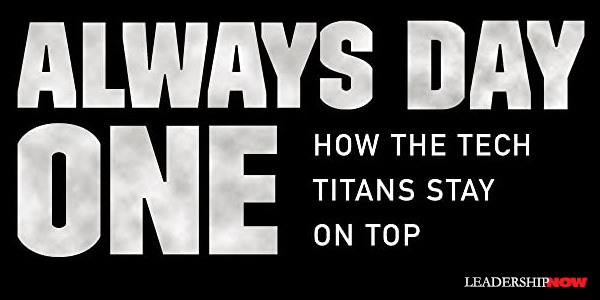 |
 |
06.24.20

Always Day One
CREATING an innovative culture is not easy. It often defies convention. Organizations that continuously innovate have common characteristics. By examining some of the most inventive companies on the planet—Amazon, Facebook, Google, Apple, and Microsoft—we can learn valuable lessons to apply in our own situation. Alex Kantrowitz does just that. He presents case studies of these five tech giants in Always Day One. It not really about always day one, but I presume he chose the title because day one is a mindset that is foundational to sustaining an innovative culture. It is a mindset that forms the bedrock of these organizations—it drives them. And when they lose that, they begin to stagnate. The case studies also provide ample examples of pitfalls we should avoid too. Day One is inventing with almost complete disregard for current revenue streams. It’s nimble like a start-up. And as Kantrowitz points out, it is minimizing execution work to make room for more invention. To continually turn new ideas into reality, “the tech giants have had to rethink the way a company is run. Loaded down with execution work, most companies today typically develop a few ideas handed down from the top, and focus on selling them. That is why ‘visionary’ is still the ultimate compliment for the CEO today. Bezos, Zuckerberg, Pichai, and Nadella aren’t visionaries, though: they’re facilitators.” When Bezos was asked in a meeting, “What does Day Two look like?” he responded, “Day Two is stasis, followed by irrelevance, followed by excruciating, painful decline, followed by death.” Amazon has a Day One culture of invention. “Bezos automates everything he can so they can invent more.” Amazon currently employs over 200,000 robots to work alongside a workforce of approximately 800,000 humans. “The robots are the most visual example of Bezos’s obsession with automating whatever he can to free his employees to work on more creative tasks.” At Facebook, when it comes to feedback, hierarchy doesn’t matter. Zuckerberg listens and learns. As people began to spend more time on their phones, Facebook needed to design for mobile or risk becoming a dinosaur. “The myth about Facebook’s mobile transformation is that Zuckerberg had an epiphany and brilliantly repositioned his company for the age of the smartphone. This isn’t quite right. The real story is Zuckerberg set up a feedback culture. And when people bought in, they brought him ideas—tough ideas that required rethinking how the company operated—and those ideas ultimately saved Facebook from disaster.” Google’s strength is its culture of collaboration. Google’s communication “linking its employees in a collective consciousness and breaking down the typical boundaries between divisions.” Ideas move fast, allowing Google to reinvent itself multiple times to keep pace with changing times. Always Day One. Apple has operated like Day One but struggles today under a refiner’s mindset. Innovation from the top worked for a while under Jobs, but under Tim Cook, it is not the same. To avoid leaks, Apple’s product development takes place in extreme secrecy. Employees not directly involved in the development are kept in the dark. Collaborative communication tools like those found inside Google are not at work at Apple. Not much has changed at Apple since Jobs. When Kantrowitz asked Steve Wozniak what would make Apple more inventive, he said, “Let the lower-level managers make the decisions. More responsibility to the lower levels.” Under Steve Ballmer, Microsoft was “bureaucratic and slow, and clung to the past. Focused on protecting its lucrative legacy businesses, Windows and Office, Microsoft prioritized profit over invention, developing a command-and-control culture that optimized for the short term.” In 2014 when Satya Nadella became CEO, he sought to change all that. “Tightly holding on to Windows would no longer be tenable. Microsoft needed to risk its core business and focus on its remaining bright opportunity—cloud computing—or endure ‘irrelevance, followed by excruciating, painful decline, followed by death.” Nadella returned the company to Day One. Each case study carefully documents each organization’s strengths and struggles as they learn to adapt and grow. The future puts a value on inventiveness—creativity, originality, and initiative. If future leaders are going to succeed, we are going to need to begin to teach this kind of thinking rather than teaching to conformity and repetition, says Kantrowitz. Students today are “obsessed with the answer when they should be asking questions.” 
Posted by Michael McKinney at 07:03 PM
|
BUILD YOUR KNOWLEDGE
 

How to Do Your Start-Up Right STRAIGHT TALK FOR START-UPS 
Grow Your Leadership Skills NEW AND UPCOMING LEADERSHIP BOOKS 
Leadership Minute BITE-SIZE CONCEPTS YOU CAN CHEW ON 
Classic Leadership Books BOOKS TO READ BEFORE YOU LEAD |